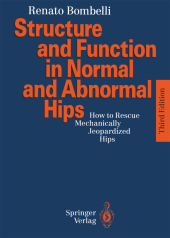 Neuerscheinungen 2011Stand: 2020-01-07 |
Schnellsuche
ISBN/Stichwort/Autor
|
Herderstraße 10
10625 Berlin
Tel.: 030 315 714 16
Fax 030 315 714 14
info@buchspektrum.de |

Renato Bombelli
Structure and Function in Normal and Abnormal Hips
How to Rescue Mechanically Jeopardized Hips
3. Aufl. 2011. viii, 211 S. 423 SW-Abb. 270 mm
Verlag/Jahr: SPRINGER, BERLIN 2011
ISBN: 3-642-77979-4 (3642779794)
Neue ISBN: 978-3-642-77979-4 (9783642779794)
Preis und Lieferzeit: Bitte klicken
Biomechanical principles, properly understood, can be used in an innovative approach to evaluate both normal and mechanically abnormal hips. In a completely revised and enlarged edition of his classic on the subject, Dr. Bombelli once again proves his expertise in interpreting the forces responsible for the physiological function or pathological decay of the hip. The third edition, with the new title Structure and Function in Normal and Abnormal Hips, presents more than 250 new illustrations that help you understand the advanced concepts that are comprehensively discussed in the text. The insights gained here have clear implications for the why, when, and how of surgical procedures. From the reviews of the second edition: "...the book supports the author´s contention that a detailed examination of radiographs will allow an understanding of the bio-mechanics and evolution of the pattern of degenerative change in osteo-arthritis of the hip, and will allow intelligent planning of surgery... I would warmly recommend this text..." - The British Journal of Radiology - "This book is a must for those of us about to consider a THR and for those radiologists interested in the why and wherefore of this common joint lesion." - Australasian Radiology - "This is a beautifully illustrated book and provides worthwhile reading for orthopaedic registrars and surgeons interested in surgery of the hip joint." - South African Medical Journal
1 Introduction.- 2 Biomechanical Interpretation of the X-rays of the Hip Joint: Interpretation of Pelvic X-rays.- 2.1 X-rays of the Normal Pelvis.- 2.1.1 The Sourcil.- 2.1.2 The Gothic Arch.- 2.1.3 The Hourglass.- 2.2 How to Interpret the X-ray Appearances.- 2.2.1 Fischer´s Model: Phases of Gait and Path of the Centre of Gravity.- 2.2.2 Pauwels´ Model: Path of Centre of Gravity.- 2.2.3 Previous Knowledge of Muscle Function.- 2.3 Interpretation of Muscular Activity According to the Gothic Arch.- 2.3.1 Static Forces Acting on the Normal Hip: New Model.- 2.3.2 Dynamic Forces Acting on the Normal Hip.- 2.3.3 The Abnormal Hip.- 2.3.3.1 Craniolateral Inclination of the WBS.- 2.3.3.2 Craniomedial Inclination of the WBS.- 2.3.3.3 Coxa Valga with a Horizontal WBS.- 2.3.3.4 Coxa Valga with an Oblique WBS.- 2.3.3.5 Coxa Vara with a Horizontal WBS.- 2.3.3.6 Coxa Vara with an Oblique WBS.- 2.3.4 Consequences of Abnormal Hip Function.- 2.3.4.1 The Antalgic Gait.- 2.3.4.2 The Duchenne or Short-Leg Gait.- 2.3.4.3 The Trendelenburg Gait.- 2.3.4.4 Friction.- 2.3.5 Conclusions.- 3 Biomechanical Interpretation of Femoral X-rays.- 3.1 Relationship Between the Physis and the Neck-Shaft Angle.- 3.1.1 Coxa Valga.- 3.1.2 Coxa Vara.- 3.1.3 Slipped Capital Epiphysis.- 3.1.3.1 Pathogenesis.- 3.1.3.2 Treatment.- 3.1.3.3 Statistics.- 3.2 The Adult Femur.- 3.2.1 Femoral Spherical Sector: Static.- 3.2.2 The Centre of Stress.- 3.2.3 Femoral Spherical Sector: Dynamic.- 3.2.4 Osteophytes.- 3.2.4.1 Positive Tension Osteophytes.- 3.2.4.2 Negative Tension Osteophytes.- 4 Osteotomies.- 4.1 Pelvic Osteotomy.- 4.2 Intertrochanteric Osteotomy: Classification of OA.- 4.2.1 Valgus-Extension Osteotomy.- 4.2.1.1 Aims of Valgus-Extension Osteotomy.- 4.2.1.2 How to Plan a Valgus-Extension Osteotomy.- 4.2.1.3 Operative Procedure.- 4.2.1.4 Postoperative Care.- 4.2.1.5 Valgus Osteotomy in Medial OA.- 4.2.1.6 Effect of Valgus Osteotomy on the Knee.- 4.2.2 Varus Osteotomy.- 4.2.2.1 How to Calculate the Angle of Varus.- 4.2.2.2 Technique of Varus Osteotomy.- 4.2.2.3 Postoperative Care.- 4.2.2.4 Effect of Varus Osteotomy on the Knee.- 4.2.2.5 Trochanteric Displacement.- 4.3 The Role of Joint Cartilage.- 5 Bone Elasticity.- 5.1 How to Preserve Bone Elasticity in Total Hip Replacement.- 5.1.1 The Cup.- 5.1.2 The Stem.- References.


